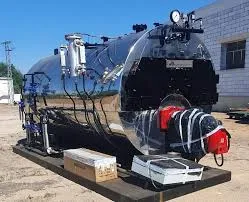
Dec . 07, 2024 01:07 Back to list
coal steam boiler
Understanding Coal Steam Boilers An Overview
Coal steam boilers have been an integral part of industrial processes and power generation for many decades. As an essential component that converts thermal energy into mechanical energy, coal steam boilers utilize coal as a primary fuel source. This article will explore the working principles of coal steam boilers, their advantages and disadvantages, as well as their environmental and economic implications.
Working Principles
At the core of a coal steam boiler's operation is the process of combustion. Coal is burned in a furnace, generating heat that converts water in a boiler drum into steam. The steam produced can then be utilized for various applications, such as electricity generation, heating, and driving steam engines.
The boiler system typically consists of several components, including the furnace, steam drum, economizer, superheater, and various safety and control devices. The combustion of coal generates hot gases, which pass through heat exchange surfaces. The heat is transferred to the water, thereby raising its temperature. As the water reaches its boiling point, it transforms into steam. The design of the boiler—such as its size, arrangement of tubes, and type of fuel—affects its efficiency and output.
Advantages of Coal Steam Boilers
One of the primary advantages of coal steam boilers is their ability to utilize abundant coal reserves, especially in regions with limited access to other energy sources. Coal is one of the most widely available and cost-effective fuels globally, making it an attractive option for energy production. Furthermore, modern coal steam boilers have been designed to achieve high efficiency levels, converting a significant portion of the fuel's energy into steam.
Additionally, coal steam boilers can be scaled to meet the energy demands of various applications. They are capable of producing large quantities of steam, suitable for industrial sectors such as manufacturing, textile, and food processing. This flexibility makes them a reliable choice for industries requiring a steady and substantial supply of steam.
coal steam boiler

Disadvantages and Environmental Impact
Despite their advantages, coal steam boilers face several disadvantages, particularly in terms of environmental impact. The combustion of coal releases a variety of greenhouse gases, most notably carbon dioxide (CO2), which contributes to global warming and climate change. In addition, burning coal emits pollutants such as sulfur dioxide (SO2) and nitrogen oxides (NOx), which can lead to acid rain and respiratory issues.
To mitigate these environmental concerns, many coal steam boilers are now equipped with advanced emissions control technologies. These include flue gas desulfurization systems to reduce SO2 emissions and selective catalytic reduction systems to minimize NOx emissions. However, implementing such technologies can increase the operational costs and complexity of coal boiler systems.
Economic Considerations
The economics of coal steam boilers can vary significantly based on location, fuel availability, and regulatory environment. Although coal remains a cost-effective energy source, the rising costs associated with compliance to environmental regulations and the transition towards cleaner energy sources pose challenges for coal-based power generation.
Moreover, as countries commit to reducing their carbon footprints, the future of coal steam boilers may be uncertain. Many governments are investing in renewable energy technologies and phasing out coal-driven systems in favor of cleaner alternatives. This shift may compel businesses to evaluate the long-term viability of operating coal steam boilers.
Conclusion
Coal steam boilers continue to play a crucial role in many industries around the world. With the ability to produce large quantities of steam reliably and cost-effectively, they are fundamental to numerous processes. However, the environmental implications of using coal as a fuel source cannot be overlooked. As the world moves toward sustainable energy solutions, the future of coal steam boilers may hinge on technological advancements, regulatory changes, and a global commitment to reducing greenhouse gas emissions. The path forward will require careful consideration of both economic and environmental factors to ensure a balanced and responsible energy landscape.
-
Oil Fired Hot Water Boilers Sale - High Efficiency & Affordable
NewsJul.31,2025
-
High-Efficiency Commercial Oil Fired Steam Boiler for Industry
NewsJul.30,2025
-
High-Efficiency Biomass Fired Thermal Oil Boiler Solutions
NewsJul.30,2025
-
High Efficiency Gas Fired Thermal Oil Boiler for Industrial Heating
NewsJul.29,2025
-
High-Efficiency Gas Fired Hot Water Boiler for Sale – Reliable & Affordable
NewsJul.29,2025
-
High Efficiency Biomass Fired Hot Water Boiler for Industrial and Commercial Use
NewsJul.29,2025
Related PRODUCTS






















